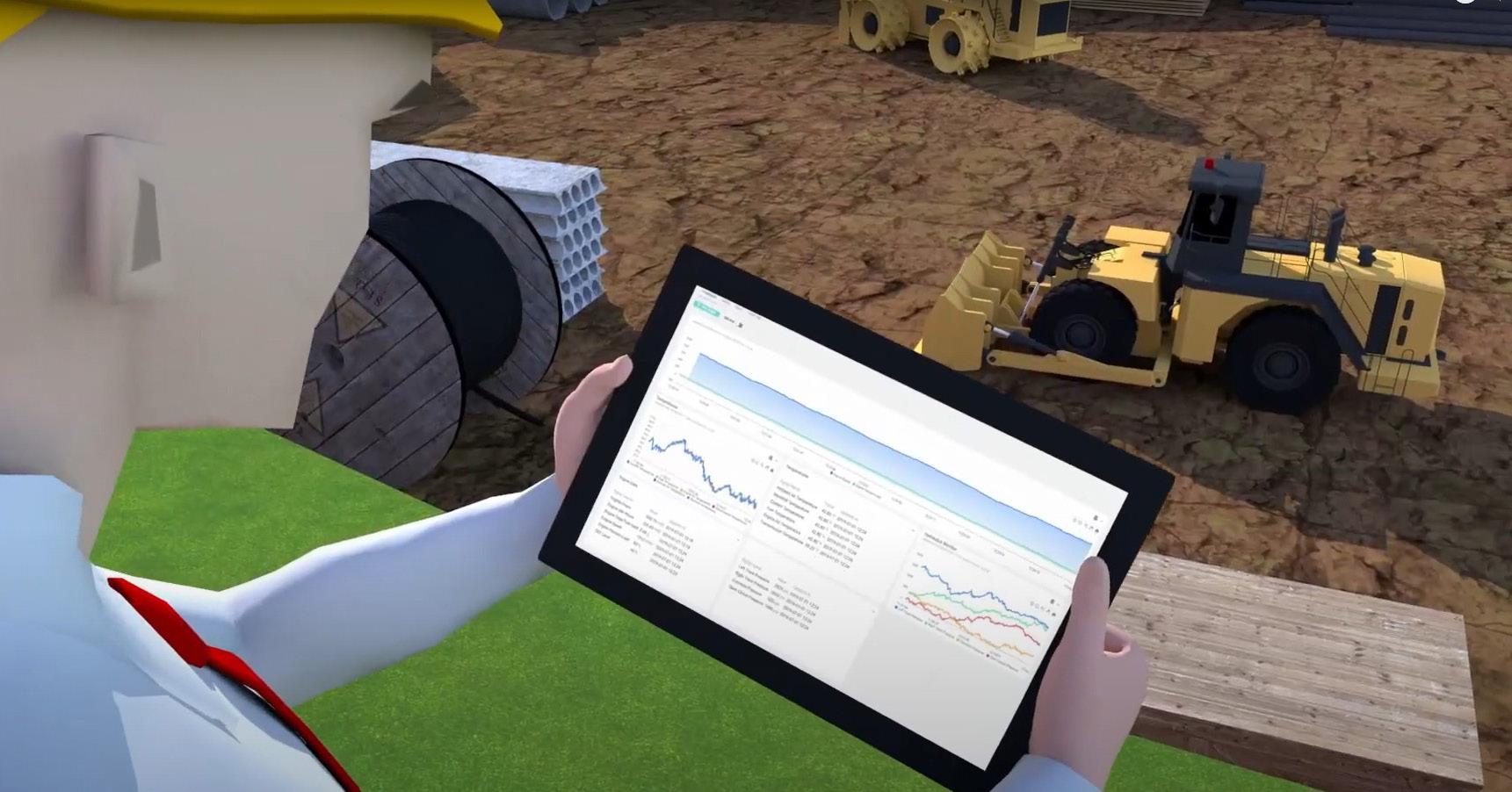
29 minute read
GPS TECHNOLOGY GETS MORE INTEROPERABLE, AVAILABLE & SMARTER
Open systems, shared communication standards, satellite and intelligence are driving more interaction between machine telematics.
Elevat IoT
Construction equipment users and construction executives operating mixed fleets have struggled with original equipment manufacturer (OEM) proprietary telematics systems. Executives responsible for a contractor or rental fleet have had to choose between disjointed systems or try to port limited amounts of data into a solution from companies like Tenna, Fleetio or multiple multifunction software applications that also offer equipment telematics features, such as Assignar or HCSS.
Yet the OEM telematics category is growing at a rate of about 15.6% annually. And the capabilities of both OEM and independent telematics systems have expanded to include not just location and maintenance codes, but productivity, safety, cost efficiency and compliance. This data is not used just to support the asset through a defined condition-based maintenance application, but must be usable by a broad spectrum of operational and analytics systems.
MORE OPEN APIS
Stock telematics solutions coming to market in the coming months and years will be more open as OEM vendors recognize and yield to the needs of the market. Telematics solutions that don’t work and play well with other technologies will put OEMs at a disadvantage, as their customers want to see all their equipment across a mixed fleet on a single pane of glass.
According to Adam Livsay, co-founder and chief commercial officer of industrial internet of things (IoT) vendor Elevāt, equipment vendors are waking up, smelling the coffee and making their technology stacks more open to external systems.
“The biggest change I have seen in the last few years is companies being comfortable using software APIs,” Livsay says, referring to the application programming interfaces that enable various software and hardware solutions to communicate with each other across all industries. “If an OEM designs a system that has a proprietary control software or algorithm, that sets up barriers. A tree trimming company using a piece of equipment may define utilization of a piece of equipment using that algorithm or telematics product differently than their competitor. Or the same technology is used in a different application like street sweeping and productivity must then be captured in a different way.”
It becomes easier, assures Livsay, whose company goes to market through 20 fluid power system integrators that drive its technologies into new product development (NPD) value streams for about 300 OEMs, at which point this information can be exposed to external systems that can display it or use it in different ways.
“The Association of Equipment Manufacturers (AEM) standard for mixed fleets helps,” he says. “Now it is very common for them to ask us if we have a set of APIs. Yes, we do. They ask how to interface with our APIs and we give them our documentation.”
This creates an open environment where the OEM can collect and use data as per their requirements. The customer’s operator can use that data to manage the equipment and the same data set can be exposed to other enterprise systems or point solutions used across the customer environment or even across a multi-company digital construction workflow.
AFFECTING OEM NEW PRODUCT DEVELOPMENT
This shift will primarily be felt in the new product development (NPD) process and to a certain extent among equipment users, as APIs become the plugand play approach for systems integration, equipment end users to access data for their own purposes. Specific codes thrown by a piece of construction equipment may still, however, be proprietary and incomprehensible to thirdparty telematics systems from companies like Tenna, Fleetio and others.
“We started seeing the shift about three years ago,” Livsay says. “In the last 18 months, we started to have this type of collaboration. Now, we are getting the next tranche of companies really starting to collaborate — ecosystem partners sharing information, sharing data, making it easier to get that proprietary data out. So, in the next year to four or five years, connected machines getting access to other connected machines will become a lot easier and the data system a lot richer.”
A more collaborative NPD process, cheaper sensors and controls, affordable IoT cell connectivity and cloud architectures that are likewise more easily integrated, all contribute to a telematics sector that will generate a more robust data set usable in more and different ways.
“We will see more machine data coming off hydraulics systems and the machine itself, including from safety sensors on seatbelts and other components,” Livsay states. “We’ll see more work information and productivity information being shared.”
According to IoTco Managing Partner and Chief Evangelist Mohamed Abuali, interoperability is becoming the watchword across multiple equipment classes and technologies.
“I think there is more openness now for all types of devices and things to interoperate and speak with a common language to the free world,” Abuali says. “Hitachi, for instance, created an approach for their vehicles to speak in a very common way using ZCORE, which is a data logger that performs AI on the edge, as well as the ability to send data to an external IoT platform using open standards. That is a very strong move toward interoperability, as well as connectivity and AI on the edge.”
BALANCING CLOUD AND EDGE COMPUTING
The telematics sector, as it becomes more central to how heavy equipment is operated, is coming to market with a more robust approach to communicating with the cloud. Equipment operated outside of cell phone range, either due to distance or obstructions, still must be able to log data on the piece of equipment itself and communicate with an operator on site. Increasingly, telematics and IoT devices will include a dual-mode or even multi-mode communication features.
According Abuali, telematics equipment will increasingly complete substantial computing at the edge, local to the device rather than in a cloudbased application. Abuali and his company help OEMs embed IoT and predictive analytics software in their products and have worked on equipment product lines from Komatsu and Kion.
“The whole premise is these types of equipment are used in remote locations that are inaccessible. We find it is essential to have remote monitoring as a service,” says Abuali. “When internet connection is not available, satellite communication is needed.”
The satellite will not relay information in real time and packet loss means only so much data can make the trip. So, the equipment must make choices about what data to send over the satellite uplink.
“We have a very special approach where data is collected on a data logger on the machine itself,” Abuali notes. “If you consider a piece of equipment like a big excavator... there will be some AI happening on the edge on the data. When the internet connection opens once a day, the AI has made some decisions regarding the critical components, the health of these components, and can send this information to a spare parts system.”
The edge system must prioritize and perform diagnostics so that it can then request specific actions to be taken within the cloud-based operations and maintenance system.
“The equipment informs that system whether any maintenance services are required, looking at the engine, brakes, tires, hydraulics and other components,” Abuali explains. “By then

Many types of equipment are used in remote locations, making it essential to have remote monitoring as a service.
ACBM staff
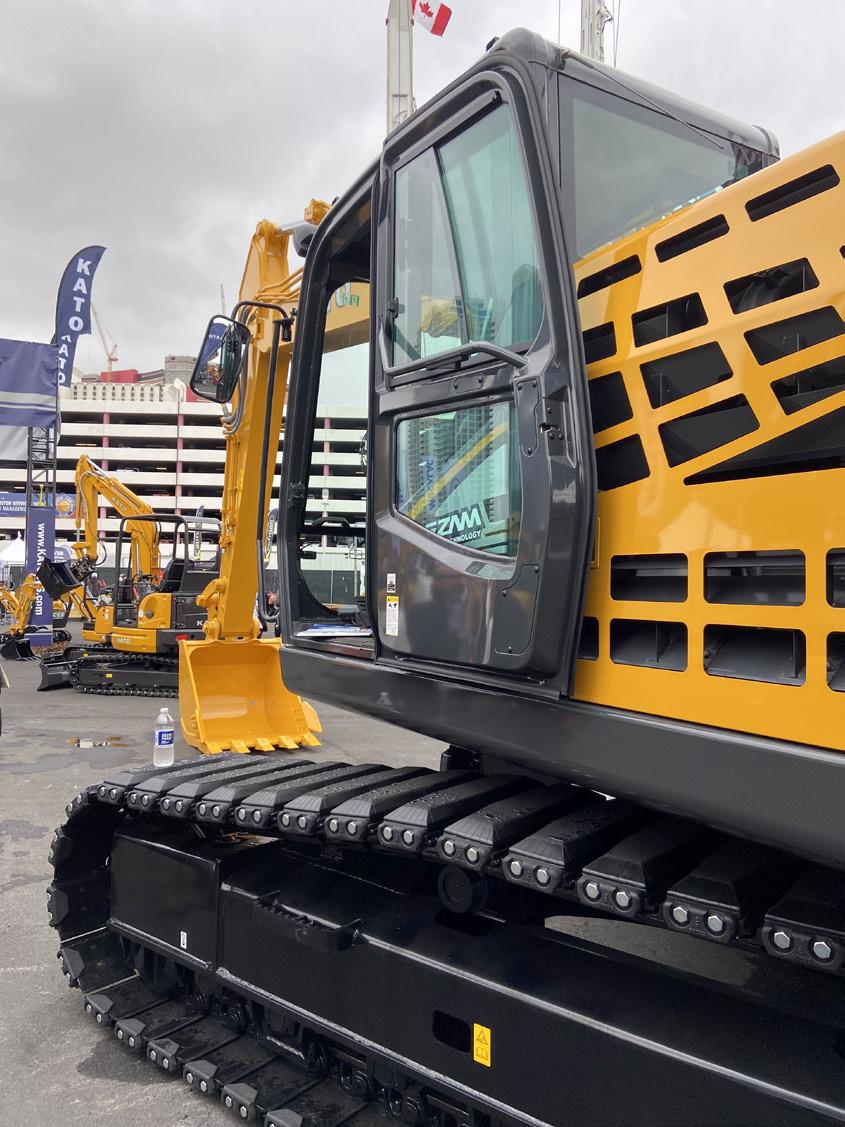
A more collaborative new product development process, cheaper sensors and controls, affordable IoT cell connectivity and cloud architectures that are more easily integrated, all contribute to a telematics sector that will generate a more robust data set usable in more ways. The Association Equipment of Manufacturers’ standard for mixed fleets creates an open environment, where the OEM can collect and use data as per their requirements and those of their customers.

connecting to the service system, it can auto-generate a work order and request spare parts. The goal is to move from a reactive failure approach. AI on the edge on a vehicle is able to make diagnostic decisions that enable predictive and condition-based maintenance.”
“We definitely see blended applications where satellite is used for certain data sets,” Livsay agrees. “We can design into the system a protocol where for cellular, we want this type of information, generally a smaller subset of data for satellite and then all the way to Wi-Fi, when we connect back to the bay at night. In situations like this, mission-critical data is communicated from the field and deeper information after the fact. Maybe we want to collect and log data points until I connect to a local network, a service laptop, cell data or Wi-Fi.”
At the edge, according to Livsay, a machine application will need to set priorities for what is related and under what circumstances how frequently.
“First priority is operator safety,” Livsay states. “After that is critical maintenance. They may also want to communicate fuel level for machines that are out there in the tundra or deep forest so they can determine fuel transfer rate. Those are the big, critical alerts. After that is the<u> </u>ability to remotely update software on the machine — maybe by satellite if there is a mission-critical update.”
While Livsay says he currently sees blended connectivity applications for telematics including cell, satellite and Wi-Fi, he also sees potential for innovative Bluetooth applications similar to Amazon Sidewalk, which is a broad peer-to-peer network of connected devices. Zigbee wireless mesh network, for instance, has solid construction and mining use cases.
NEW CONSTRUCTION BUSINESS MODELS
As telematics devices become more robust and more open, Abuali believes they will enable new construction business models by virtue of the shared visibility they create for OEMs and equipment owners.
“In many cases, it is more effective to replace parts early than wait for them to fail,” Abuali comments. “When that happens, it impacts productivity and also makes it more expensive to stock and deliver spare parts. [This] is a concern for the OEM if the vehicle is under warranty because they have to have a higher replenishment of parts and more cost to comply with responsiveness service level agreements (SLAs). For OEMs, there can be that financial tradeoff between spare part management and warranties. Forward-looking OEMS are looking at having predictive analytics embedded in the telematics unit on a machine to optimize spare part usage and enable the responsiveness they promise in the warranties”
Ultimately, telematics will support paying for equipment by usage or duty cycle.
“I have seen this in Kaeser Compressor,” Abuali says. “They went into an interesting business model of selling air instead of selling compressors.” ET

Making a Case for THIRD-PARTY TELEMATICS
Third-party telematics aggregate data from all manufacturers and equipment to present it in easily understandable formats.
Telematics has become increasingly popular within the heavy equipment industry, with virtually all manufacturers offering their own version. OEM telematics typically gather data such as engine temperature, rpm, fuel, pressures and fault codes. The data is available through a login unique to that brand of machinery, thus requiring the owner to log in separately for each brand of equipment owned.
With most companies owning multiple brands of equipment, managing login information can be a challenge. Since each manufacturer presents their data in a different manner, information is not easily discerned “at a glance,” but requires aggregation and interpretation.
The data gathered from OEM telematics confirms that the equipment is used within its designed parameters for evaluation and troubleshooting. Manufacturers include telematics to let them know when equipment is due for preventive maintenance, if it has been run too hard and whether the warranty is valid. While the data provided may help manage that piece of equipment, it does not help the owner to better manage the project that the equipment is used on.
Third-party telematics, on the other hand, aggregate the data from all manufacturers and all equipment types and classes to present it in easily understandable formats so that managers can make decisions in real time.
IDLING PROBLEMS SOLVED
Let’s look at idle time, for example. OEM telematics can monitor rpms to determine whether equipment is idle or working. But knowing if a machine is idle for a point in time is not nearly as important as determining a trend and being able to intervene. A third-party option such as FleetWatcher’s Escalating Idle Alert informs managers when an idle time threshold has been exceeded so they may take corrective action.
Here’s how it works. Users set an acceptable idle time and then enter that into the third-party telematics platform. When that threshold has been reached, an alert is sent, usually via email or text, to the foreman. If the unit continues to idle, a second alert is sent 5 to 10 minutes later to the foreman, superintendent, maybe also a project manager or equipment manager. If needed, a third alert, also 5 to 10 minutes later, is sent to the boss, a guy that most folks don’t want to be advised of this sort of situation. Generally, the problem is resolved, and idling is eliminated, after the first or second alert. The parameters and alerting structure are completely customizable by the user.
So how big is the idle time problem? Over 20 years of experience in collecting company data has shown that most companies have idle times across their fleets that average more than 50%. In addition to wasting fuel, excessive idle time costs companies in lost value, including lost production.
Before installing the system, one customer turned in a loader at the end of its useful life and it had idled over 60% of the hours. Had the system been in place, they could have cut the idle time dramatically, nearly doubling the useful life of the machine.
SIMPLIFIED SCHEDULED MAINTENANCE
OEM telematics can determine when specific pieces of equipment are due for preventive maintenance (PM), but require multiple logins to manage the fleet. With a third-party system, all equipment within 36 hours of its PM is shown in yellow, with equipment at or past its PM timing shown in red. Units can be tracked in hours or miles. This “at-a-glance” status makes it easy to see what needs attention and can simplify scheduling of getting equipment into the shop.
One customer would PM equipment as it came off a job, which was an easy fix for them. With third-party telematics, the customer determined that they were performing PM about twice as often as was needed, so they were able to save money with better scheduling.
STEALING GLANCES BUT NOT EQUIPMENT
GPS makes it easy to track where equipment is, but third-party telematics takes it a step further and provides a breadcrumb trail feature that tells you where it’s been, and more.
One customer, upon realizing that a new skid steer had been stolen, was thankful that they had installed FleetWatcher. He used the breadcrumb trail feature to lead them to the skid steer, as well as the new forks, which had been deposited in another location.
IT’S YOUR DATA, SO USE IT

The data collected by OEM telematics is your data to use any way that you would like. Third-party telematics systems gather OEM data and deliver it in a way that is easy to understand and act upon.
Multiple times throughout the day the system collects specific and customized data from the fleet. In addition to maintenance due data, it collects and reports on fuel monitoring, showing amount of fuel in tank, consumption, refills, etc., as well as engine temperatures, pressures and fault codes. This information is then processed and delivered in the specific format desired.
Useful reports (which are available online or in Excel format) can be shared with the whole operations team if desired. With more than 20 reports and hundreds of filtering options available, teams have the information they need to manage everything from a quality preventive maintenance program to equipment costs and operator performance.
Data can be integrated with other business systems, such as accounting, estimating and job cost systems, bringing everything together for a more comprehensive view. FleetWatcher tracks multiple data points including cycle times, productivity and downtime, equipment utilization and under-utilization, exact location of each piece of equipment, project status, budgets, shop costs, rental expenses and trends and behaviors.
While OEM telematics adds value to the particular equipment they are gathering data from, utilizing a third-party telematics system provides information on the fleet as a whole. Seeing the big equipment picture allows management to better manage their projects and the business using the data provided. ET
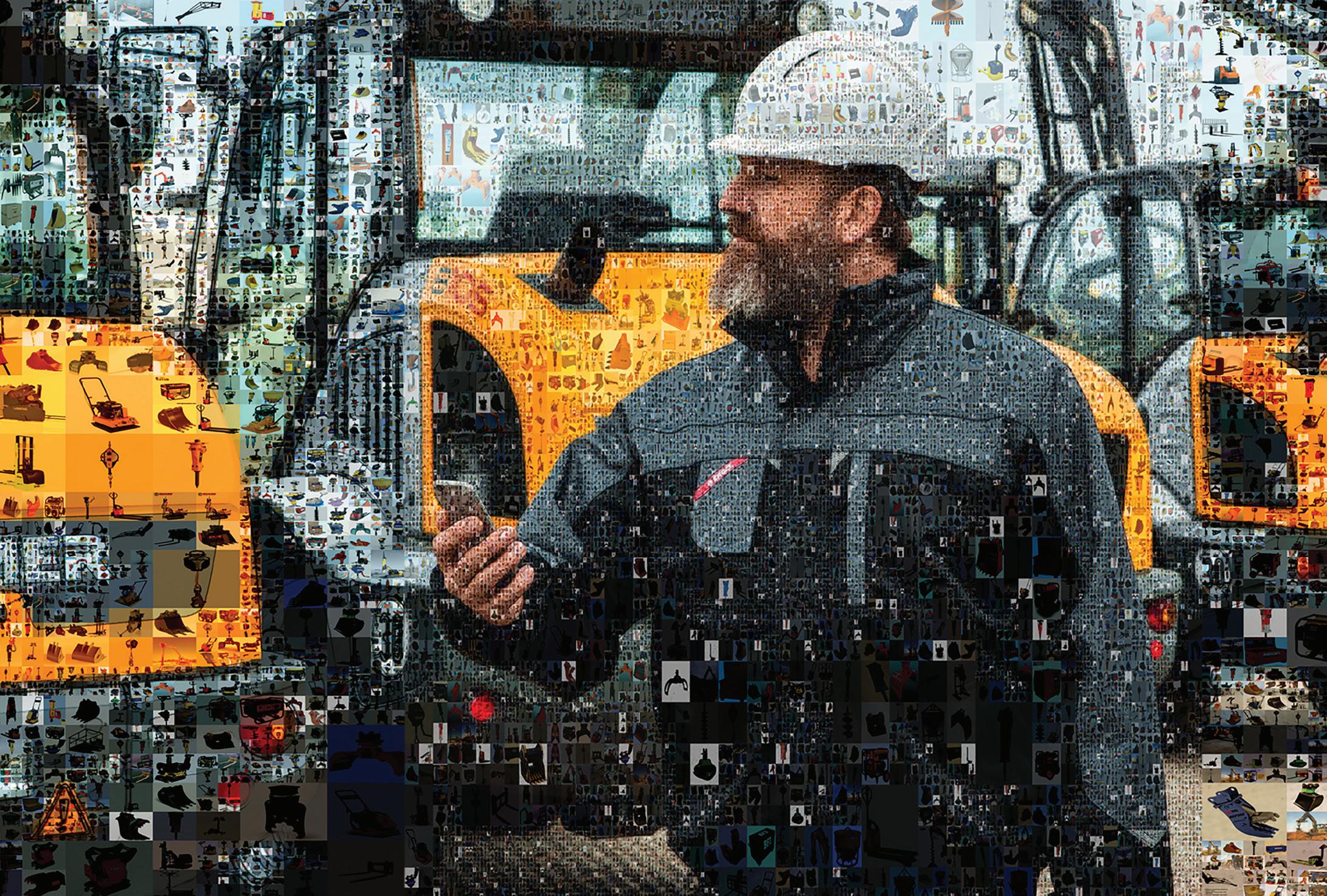
Earthwave Earthwave

RIGHT: GPS makes it easy to track where equipment is, but third-party telematics also provides a breadcrumb trail feature that tells you where it’s been.

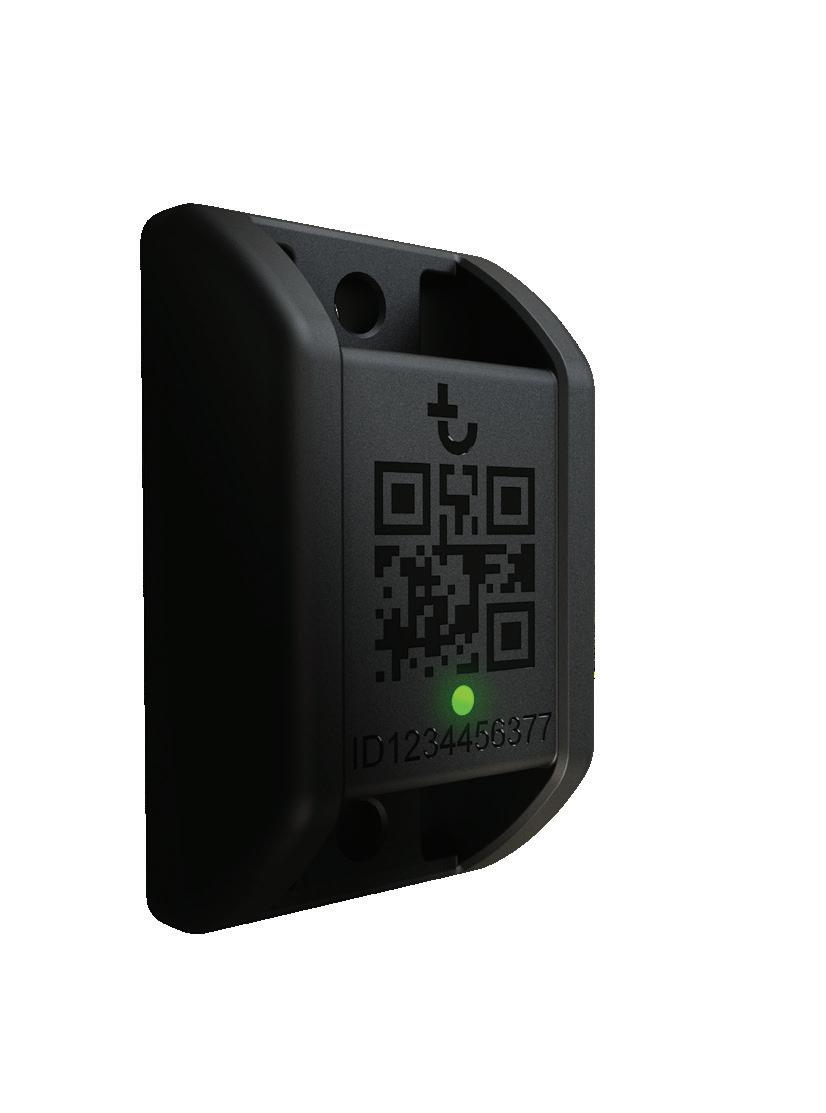
The End of Lost Assets
On average, field workers spend 90 hours every month searching for lost equipment. Tag your rammers, buckets, hammers, and tools with Trackunit Kin, and stop wasting your time.
Want to try Kin? Get a demonstration of how it works.
www.trackunit.com

How Data From Construction Wearables Can Benefit Your Construction Business
Data from wearable technology can increase productivity, prevent injury and keep workers aware of hazards and their health.
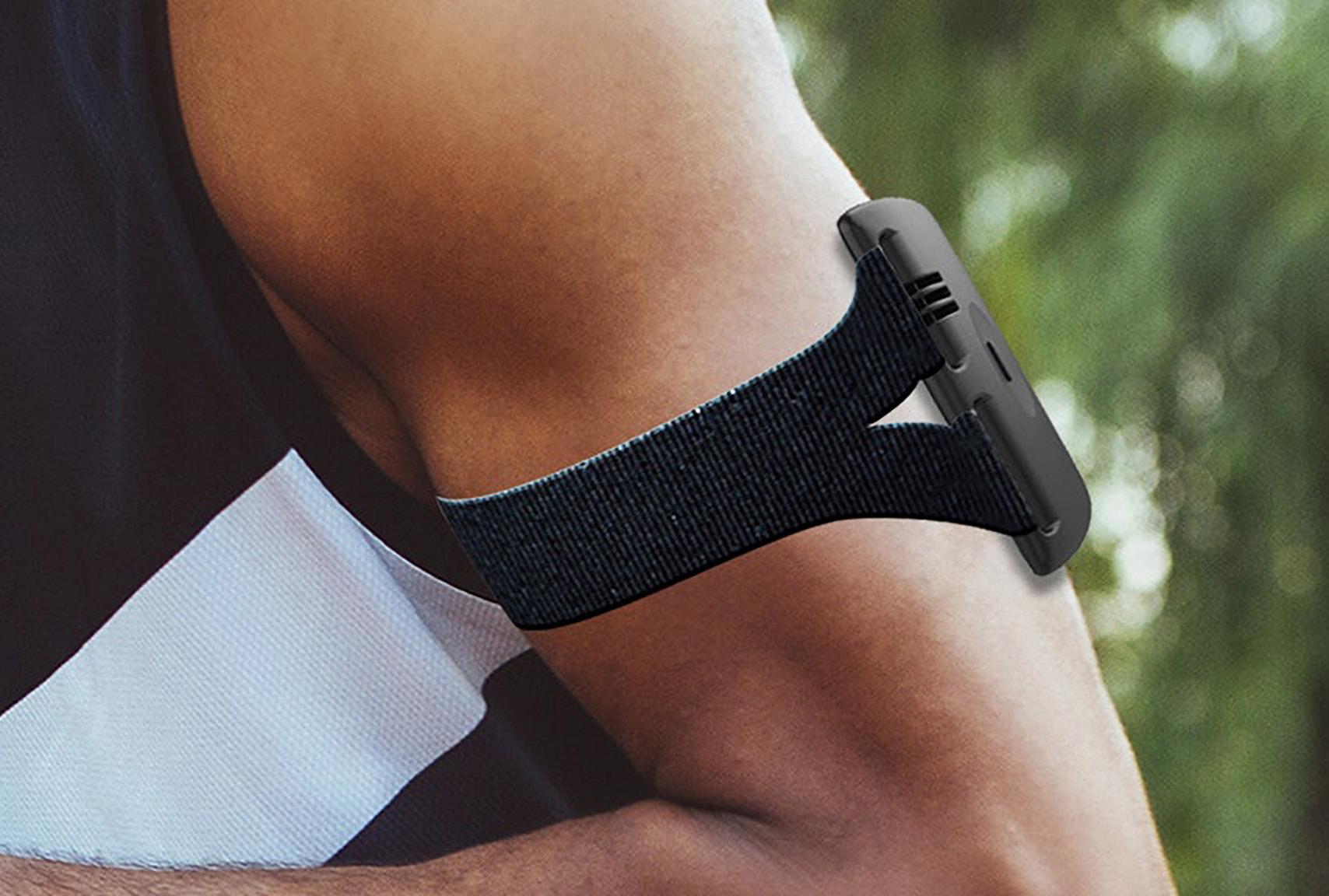
Kenzen’s Smart PPE patch monitors and relays real-time stress indicators to protect against heat injuries. It is a cloud-based SaaS system that includes a wearable device workers wear on their arms.
Construction sites are inherently hazardous environments. To mitigate job-related risks, however, companies industry wide are increasingly turning to advanced safety technologies.
The tech that’s on the rise is wearables. Smart, wearable technology on construction sites can increase productivity, prevent injury and keep workers aware of situational hazards and their health. And while a U.S. Chamber of Commerce report found that only 6% of contractors used construction wearables on site in 2018, some 83% of contractors believe that construction wearables would improve on-site safety.
Head-to-toe wearables are the future of jobsite safety. Smart hard hats, watches, monitors and boots, augmented reality glasses, exoskeletons and wearable sensors not only enhance workplace safety, but also benefit businesses by providing critical lines of communication and actionable data collection.
Here’s how equipping workers with wearables can benefit your construction firm.
INDUSTRYWIDE TECHNOLOGY RISE
Thanks to activity trackers from Apple, Fitbit and Jawbone, wristwear-segment wearables have opened the floodgates for widespread wearable technology adoption. In fact, the wearable tech market is expected to grow from $40.6 billion in 2020 to $100.4 billion by 2027, according to recent industry predictions from MarketWatch. com.
An industry readily embracing a wave of new technology (i.e., drones, equipment tagging, 3D printing, robotics, virtual and augmented reality), the construction industry as a whole is primed for mass wearables adoption. For starters, workers already wear personal protection equipment. Moreover, construction has the worst statistics for worker health and safety of all major industries. With one in five worker fatalities in 2019 occurring in construction, according to OSHA statistics, companies and employees are embracing workplace safety initiatives, like the implementation of wearable technology.
BOOST DATA VALUE
Of the potential solutions construction firms can implement, wearable devices offer a high level of user functionality and are among the most insightful. Equipped with sensors, GPS, heart-rate monitors, activity trackers, pressure, fall and gas detection, wearables can track a plethora of worker health and safety metrics. This data can in turn be used by companies to better address safety concerns across jobsites before accidents or injuries occur.
With smart watches, company leaders and field workers can communicate hands free, track jobsite movement and monitor vital signs — recording and sharing electrocardiogram rhythms and oxygen saturation levels. Wrist wearables can also detect falls and alert on-site and emergency personnel.
Wearable technology is also transforming boots, helmets and safety glasses into powerful, data-collecting and sharing devices. Pressure and location sensors placed in footwear can detect falls and shocks, track worker location and alert help. Fitted with sensor bands, hard hats become an even more critical piece of safety equipment, tracking vital signs to detect fatigue and alerting workers and equipment operators of potential collisions when paired with heavy machinery sensors. Smart safety glasses are providing workers with live-field data and updates on hazardous materials, leading edges and safety protocols.
INTEGRATE WITH EXISTING TECH

With the ability to collect and share critical data, companies need a way to sync all their tech. Enter a mobile workforce platform. Data from all wearable technology can be compiled by a mobile workforce platform and can be visualized and reported instantly from an individual, team or the entire workforce.
By integrating wearable devices and their data with cloud-based software accessible on any mobile device, companies can facilitate instant communication between managers and field workers. This open line of communication allows field workers to share their concerns and jobsite experiences with off-site company leadership who may be unaware of jobsite hazards and safety issues. When asked why getting all of your data in one place is important, James Benham, founder of JBKnowledge, said, “Once you start aggregating all the data across all of your different verticals you can start making better decisions, data-based decisions, not emotional decisions.”
Equipped with data from wearables and first-hand worker accounts, construction companies can mitigate potential jobsite risks, delays and safety issues. Addressing these concerns ahead of time helps to eliminate workplace hazards, keeping employees safe, while also delivering projects safely and on time.
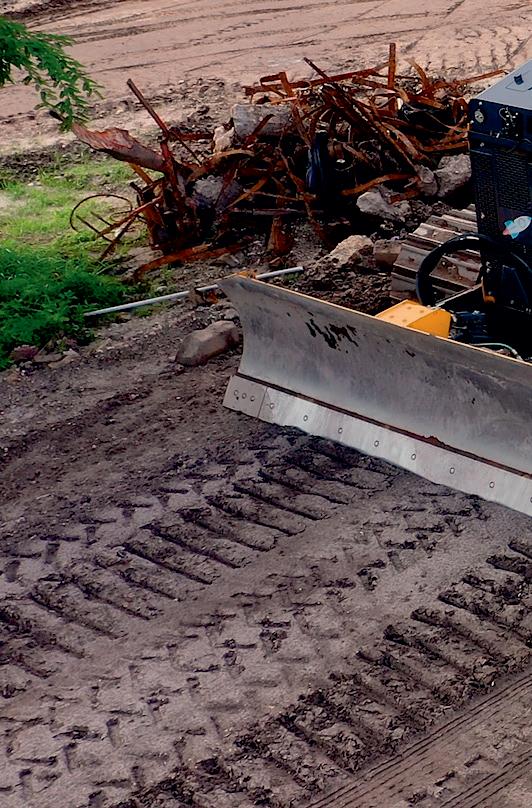
DEEP DIVE INTO YOUR BUSINESS
Use of wearable technology can give vital insight into a company’s entire operations. For one, wearables can track patterns in worker movement and equipment use to determine dips and increases in productivity. They also monitor worker health and safety, protecting a company’s most valuable asset; its people. Moreover, wearables shed light on a company’s pressure points that impact their bottom line.
By aligning the field data collected by wearables with project progress and safety reports, finances and more, companies can effectively analyze their business operations and measure key performance indicator (KPI) — a quantifiable measure of performance for a specific objective and one of the keys to having an accurate understanding of the overall financial health of the business.
“KPIs are fantastic if people take the time to understand the visibility,” said James Coyle, co-founder of Event 1 Software, on how KPI and transparency go hand in hand. Adding the KPI is even more relevant today, “because of wearable technology collecting information from the field.”
With this additional insight, departments across firms can identify targets to achieve, track milestones to gauge progress, make data-backed decisions, understand each other’s needs and work more collaboratively.
Wearable technology is taking construction safety and data collection to the next level. With the ability to collect and share critical health and safety data, wearables are preventing workplace accidents, improving incident response, increasing overall jobsite safety and effectively improving the entire operation of these companies leveraging them. ET
Triax
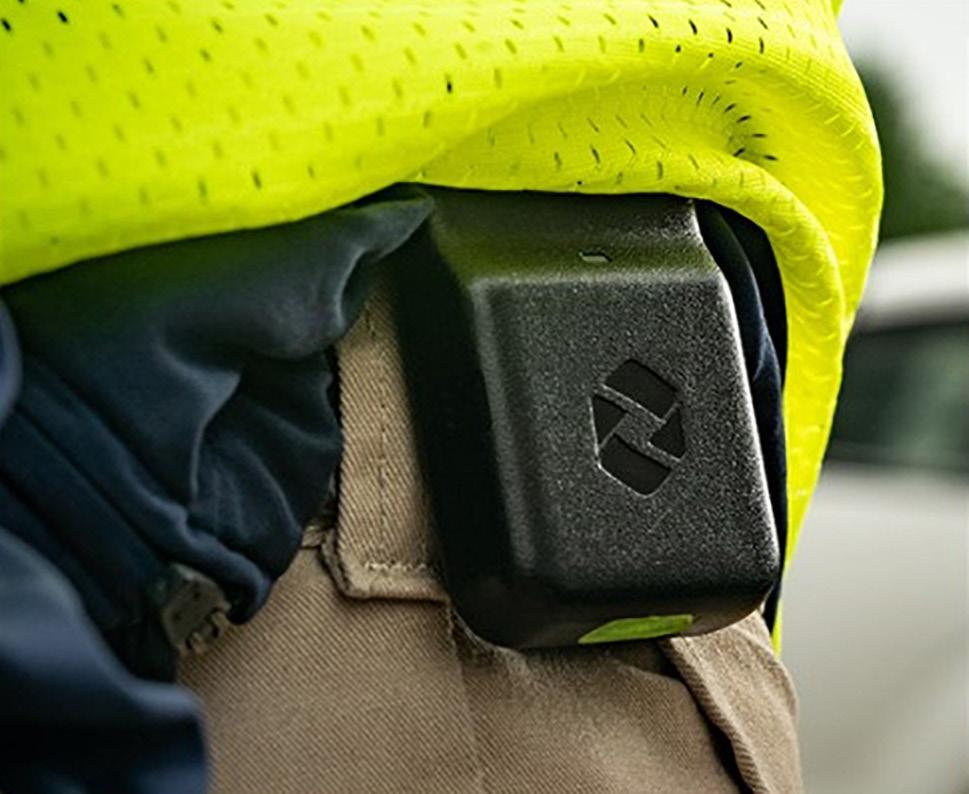
Triax Technologies’ Spot-r connected worksite solution alerts safety personnel to slip, trip and fall incidents and offers worker time and location data to improve operations and mitigate risk.
Mike Merrill is co-founder and COO, WorkMax.
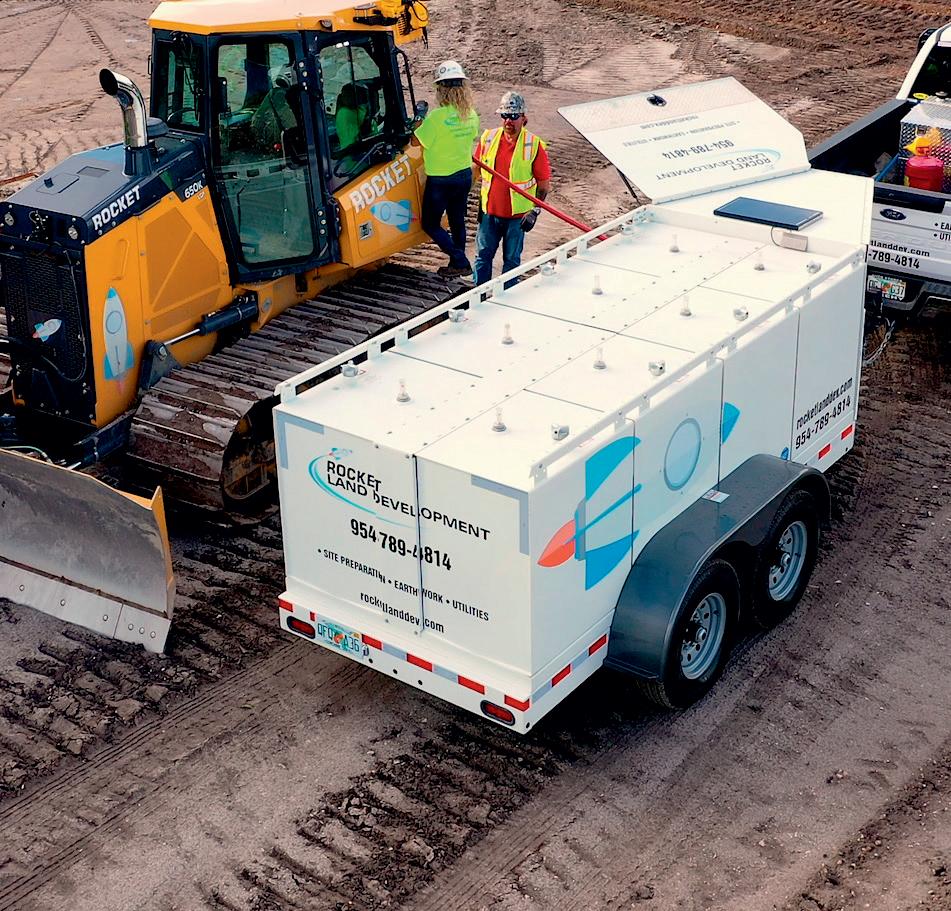
Easy Financing: $3,000 down payment based on our jobsite-ready, 690-gallon Multi-Tank Trailer and patented 100-gallon, 2-in-1 DEF system. Subject to approval. Offer valid until June 30, 2022.
Skyjack ELEVATE Live
ELEVATE Live provides access to simplified telematics data and machine-specific familiarization to anyone with an internet connection.
•Remotely indicates when machine settings are incorrect providing quick resolution •Analysis of lifting, driving, load and total run time provides true working time •Targets battery replacement costs by providing battery health and treatment analysis •Sends critical machine faults to key personnel for immediate action •Manage data through ELEVATE apps, and/or API data feed Read more at: https://myfc.pro/bv6fwu
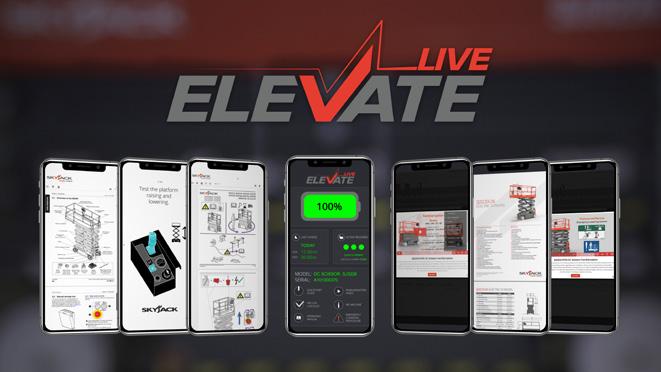
JLG ClearSky Fleet Management Telematics Solution
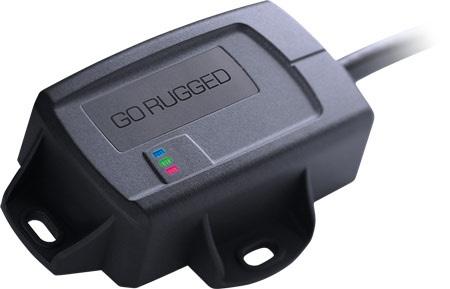
The ClearSky fleet management telematics solution provides flexible options to access critical engine and equipment operational data.
•Data points include location, engine hours, usage, fuel and battery levels and maintenance schedules. Available in real time for access from desktop or mobile devices •Monitors fault codes and critical alerts can be sent via text and email •Dashboard, settings and widgets are editable and can be prioritized to customer preferences •Available as a factory-installed option for new JLG machines or aftermarket installation kit to retrofit Read more at: https://myfc.pro/h6hwn5
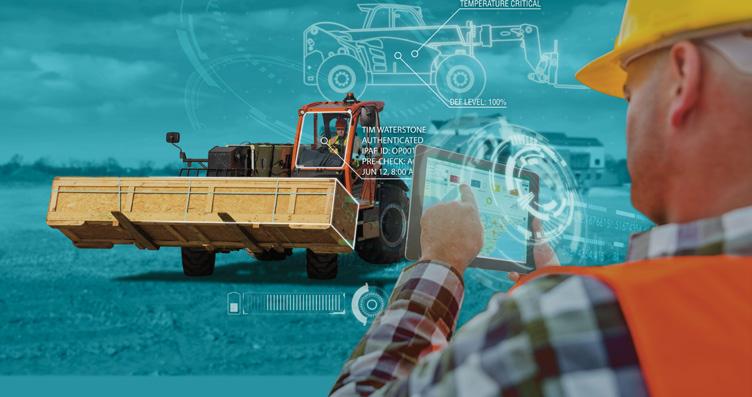
Gauge JackHammer Series GPS Tracking Products
The JackHammer series of battery-powered tracking devices include an IP69K environmental rating, -40° F to 185° F operating range and LTE Cat-M1 cellular module.
•JH-BP2 intended for non-powered assets such as trailers, storage containers or roll-off boxes and includes a 17-year battery based on one message a day •JH-BP3 for implements and attachments (buckets, jackhammers, pile drivers, etc.) allows for rapid deployment and includes a fully sealed, weatherproof design, four-year battery and optional weld-on steel guard

Read more at: https://myfc.pro/pw7h3e

The Earthmoving Productivity System enhances the measurement accuracy of volume loaded into a scraper in real time.
•Transfers critical data directly to the JDLink Dashboard via JDLink Connectivity to enable increased accuracy for job bidding and billing •Calculated yardage visible to operator during every pass, added up after each cycle and saved to show daily productivity •3D camera provides video feed to in-cab monitor to allow operators to view materials being loaded even when their view may be obstructed •Available for installation on single, double or triple scraper systems and can be retrofitted on all D-Series scrapers •Also compatible with select Scraper Special Tractors (2015 or newer) including the 9R, 9RT and 9RX models Read more at: https://myfc.pro/rdkc95
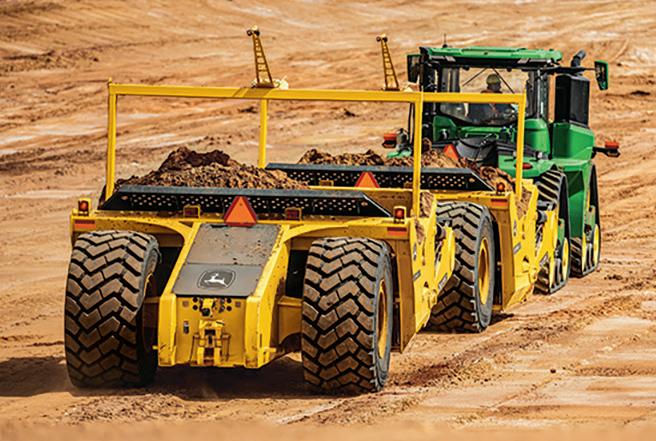
Trimble Jobsite Connectivity Bundle
The Jobsite Connectivity Bundle links 3D models and data across Trimble civil construction hardware and software solutions.
•Enables more efficient and reliable transfer of files throughout construction life cycle •Solutions connected include Trimble’s Connect Collaboration Software, Business Center, WorksManager Software and WorksOS Software •Enables interoperability between other software solutions integrated with Trimble Connect, including SketchUp, Quadri BIMsoftware and third-party solutions •Allows users to synchronize projects and data with Trimble Connect to share and collaborate on construction files and all other compatible solutions •Design data can be shared with machines and surveyors in the field using Earthworks Grade Control Platform, Siteworks Positioning Systems and Access survey software Read more at: https://myfc.pro/z785zz

Geotab GO RUGGED Fleet Tracking Device
This scalable, flexible and customizable off-road fleet solution can capture rich data on equipment position, fuel use, idling and more.
•Delivers accurate intelligence for real results •MyGeotab fleet management platform integrates with AEMP and third-party devices •IP67-rated device with LTE connectivity lets you monitor assets on the work site in realtime •Manage off-road and on-road assets together •Open platform and Marketplace offer a variety of third-party solution options Read more at: https://myfc.pro/trvgk7
Fleetio Fleet Management Solutions
Fleetio’s suite of cloud- and mobile-based fleet management solutions enables fleets of all sizes to access real-time information and get actionable insights to automate fleet operations and manage asset life cycles.
•Users can instantly access and update data regarding planned and unplanned maintenance, fuel, drivers, inspections, parts and more •Improves communication and streamlines issue resolution with mobile apps, email notifications and reminders •Integrates with telematics solutions for automated odometer updates, DTC handling and fuel location reporting •Pairs with fuel cards to automatically log transaction data at fuel up Read more at: https://myfc.pro/krem6m

YARDZ Equipment Management Platform
YARDZ is a technology platform for tracking rental and owned equipment to better understand what is in a fleet’s inventory.
•Allows users to see all rented assets in the field in one place, their location, payment terms and date each item is due back at the supplier •Offers one-click call-offs of rentals, as well as alerts and inventory summaries •Provides same level of management functionality for owned equipment plus the ability to track and schedule equipment maintenance, monitor warranty information and more •Pro, corporate, enterprise and other versions available Read more at: https://myfc.pro/jv4xpk
Genie Access Manager for Lift Connect Telematics
Access Manager is a retrofittable add-on feature that works with Genie Lift Connect telematics.
•Requires entry of a code to start the machine, ensuring only authorized users can operate it •Assigns a unique code that can be randomly generated or personally selected •Operator can be assigned to specific equipment •Access via entry of authorized code on the Access Manager keypad or via an optional authorized RFID card •Keypad features durable, tactile buttons that are easily pushed even if user is wearing work gloves Read more at: https://myfc.pro/ruummf
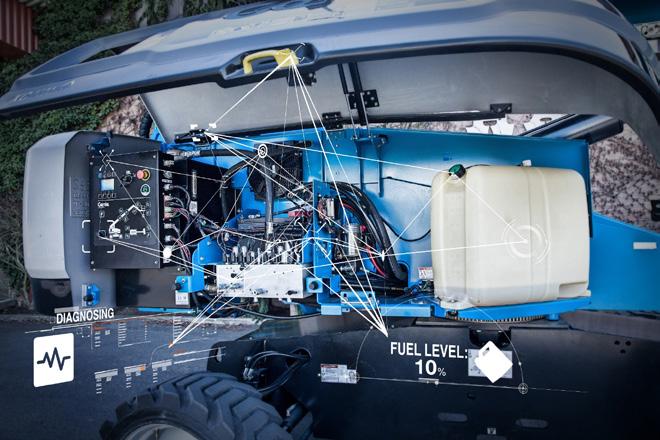
Verizon Connect Asset Tracker for Reveal
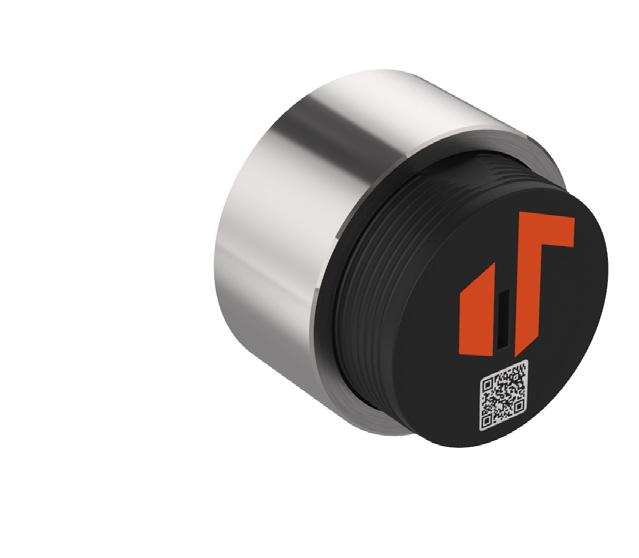
Designed for customers running their mobile business on the Verizon Connect Reveal fleet management platform, this asset tracker device offers a compact, discreet solution that is easy to conceal, self-install and self-manage.
•Helps to reduce theft, improve equipment utilization and billing and reduce equipment downtime •Replaceable battery extends the life of the device and its value •Enables users to locate and manage equipment, as well as vehicles, drivers and jobs, online through the Reveal fleet management platform or Spotlight app Read more at: https://myfc.pro/np6c7v

The FleetWatcher Real-Time Executive Scoreboard feature serves as a scorecard for the Materials Management System (MMS), allowing users to see key performance indicators (KPIs) in an easy to understand format on their phone, tablet or computer.
•Provides real-time view of tons per hour by crew or truck, feet per minute, cycle time, trucking cost per ton and more •Color coding shows at a glance which metrics need corrective action •Total tons loaded automatically compared to shift times to show users if they are ahead of schedule or behind •Metrics can be graphed to quickly show performance over time •Users can select KPIs to display and change them as desired Read more at: https://myfc.pro/fn5fc4

Tenna TennaBLE Beacon Steel Puck
The TennaBLE Beacon Steel Puck autonomously tracks the location of equipment parts, attachments, tools, trench boxes and more that get aggressive, high-impact use.
•Encased in steel and welded to asset for extra ruggedness •Sends out regular “heartbeats” that are recognized by the company’s mobile asset tracking apps for iOS and Android •App downloaded on smart device automatically identifies and records tagged asset location when in range (~100 ft.) and stores data •Non-rechargeable lithium metal battery provides long life (up to three years) even in extreme temperatures Read more at: https://myfc.pro/2zrwa9
Leica BLK ARC and BLK2FLY Autonomous Reality Capture
The BLK ARC laser scanning sensor and the BLK2FLY fully integrated, autonomous flying laser scanning sensor provide fully autonomous mobile reality capture.
•BLK ARC improves autonomous navigation of robots and other carrier platforms to deliver fully autonomous mobile laser scanning •Safely and repeatedly captures 3D point clouds and panoramic images of changing environments with minimal user intervention •BLK2FLY enables user to quickly and easily scan structures and environments accurately from the air •Advanced autonomous obstacle avoidance ensures safe flight paths Read more at: https://myfc.pro/a2kw53

Topcon MC-X Platform and MC-Max Machine Control Solution
MC-Max is a scalable solution for mixedfleet heavy equipment environments based on the MC-X machine control platform and backed by the Sitelink3D real-time, cloudbased data management ecosystem.
•Adapts to owners’ machine control and data integration needs as their fleets and workflows expand •Can be installed on a full range of dozers and excavators using the same basic modular components •Modern, redesigned user and product interfaces provide a simplified and immersive user experience •Flexible mounting solutions and optional automatic blade and bucket control for a variety of machines available Read more at: https://myfc.pro/yhv498
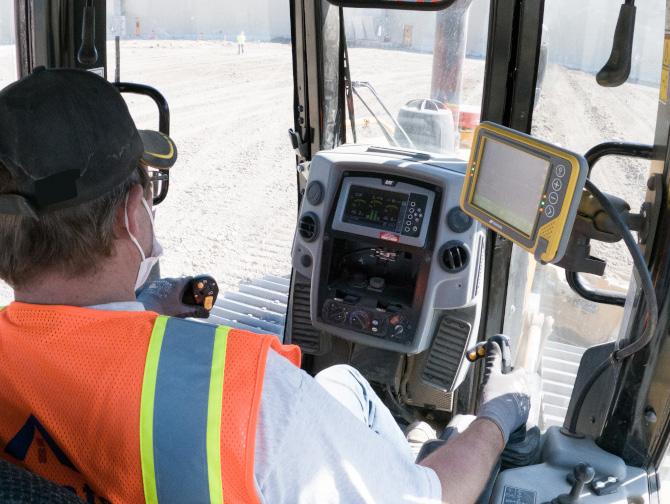
Milwaukee Tool ONE-KEY Bluetooth Tracking Tag
The ONE-KEY Bluetooth Tracking Tag provides accurate information on the last seen date, time and location of a tool within 300 ft. of any ONE-KEY device.
•Accelerometer provides information on the last time the equipment was used •Includes built-in speaker to ring the tag and locate it within 50 ft. •Built-in NFC and scannable QR code enable simple two-step activation and allow user to quickly identify a specific item even when the app is closed •Securely attaches via glue, screw, rivet or zip tie •Powered by an internal battery with a three-year run time Read more at: https://myfc.pro/u75mjq
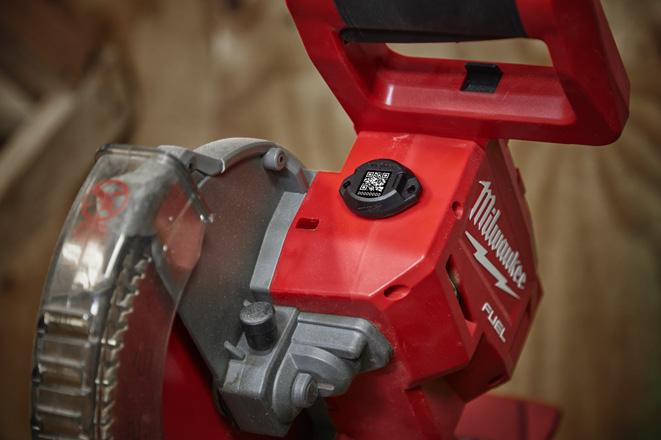
Komatsu Smart Construction Drone and Smart Construction Field
Komatsu’s suite of jobsite technologies includes new tools to help better manage projects.
•Smart Construction Field mobile app allows users to easily record jobsite activity and analyze operational efficiencies in near real time •App can collect machine data from an entire fleet regardless of brand •Smart Construction Drone survey technology captures quantities for production tracking and billing •Users can gather and analyze data throughout project phases with topographic surveys that include hundreds of thousands of data points •Still photos can be taken from up to 400 ft. above ground level or under bridge decks Read more at: https://myfc.pro/up92bx
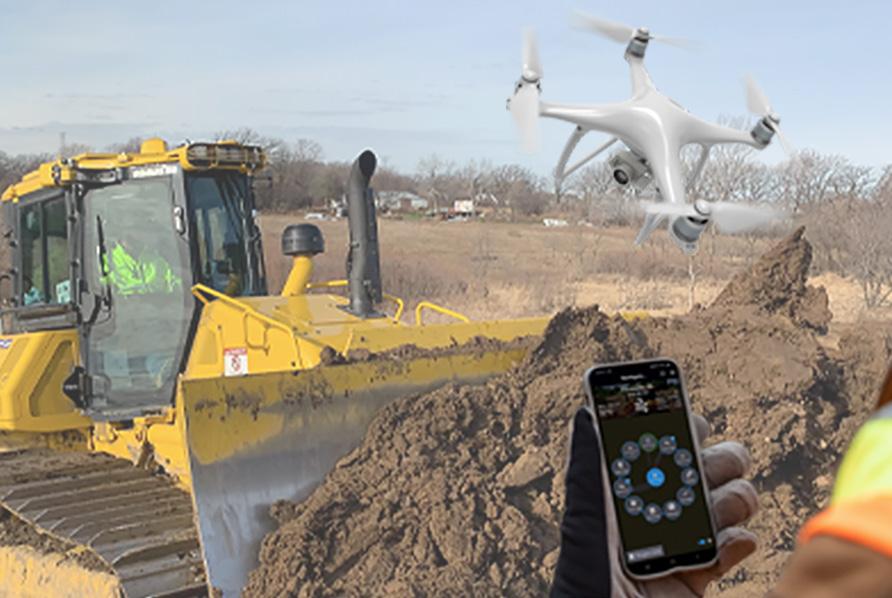
POWER IS STRENGTH




